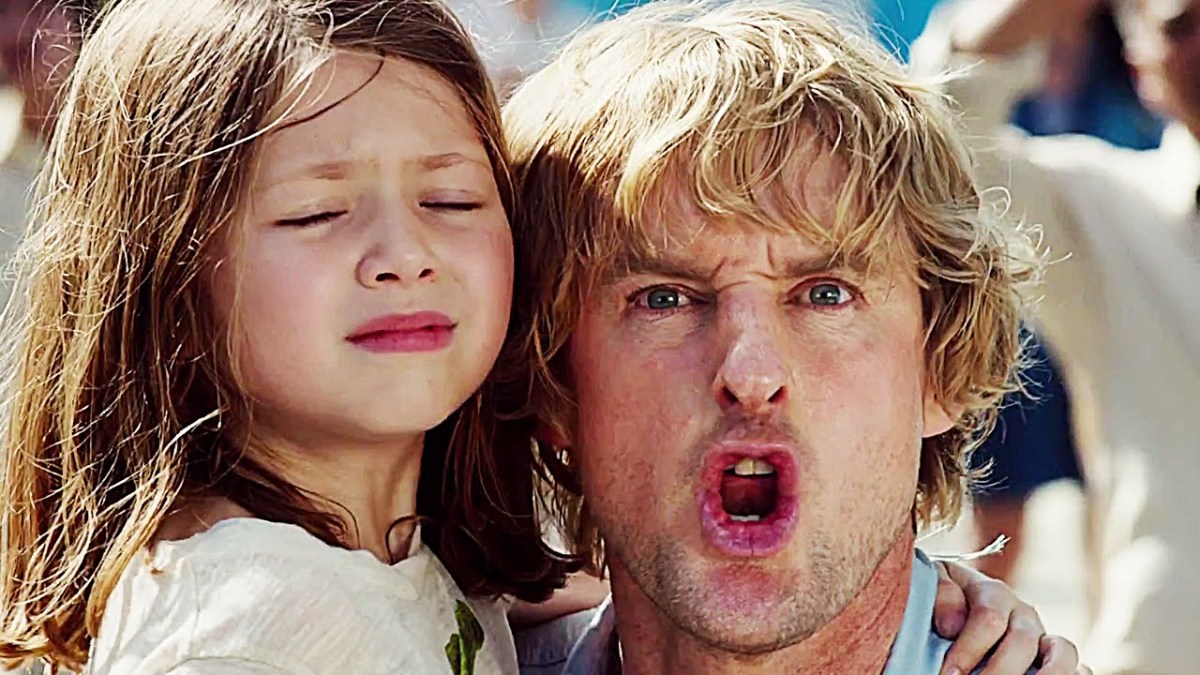Do you want to feel bad this week? Well, go see No Escape, because it will really put you in a mood. Not something that will reach you emotionally and touch your soul, it’s actually pretty mindless, heartless “entertainment” that will probably make you really, really want to take a shower. It’s that kind of bad, ugly movie, and it would be hard to find a movie that felt more xenophobic this year, which makes me wonder how this made it to theaters in this era of global movie releases. If you’ve seen the trailers (it feels like they’ve been in theaters for a year), you’ll know that this is the one that has Owen Wilson playing an action hero trying to save his family. Structurally, it seems to be made with the pitch, “It’s World War Z meets Red Dawn” … in a bad way.
Imagine having thousands of nameless, faceless, nationality-less Asian actors swarming the streets like the fast-running zombies in World War Z or 28 Days Later. Yes, there’s a political justification given for these scenes (barely), and at first, it seems like the “innocent” Owen Wilson character is just in the middle of a political conflict between rebels and government. But almost immediately, the movie becomes nothing more than a ridiculous Asians vs. Innocent White People movie, and that’s pretty gross and hard stuff to recover from in any movie—even harder when it barely has any characters or plot to cling to.
When I say “white people” I should say that there are one or two Asian characters who seek refuge with Caucasian hotel guests, but for the most part, it’s pretty “white.” There’s also an Australian, a French guy, and a couple of Brits, but the Americans last the longest, primarily thanks to Owen Wilson throwing his screaming children across buildings with the help of a nameless Asian man who will not be joining them. Literally, we see 4- and 6-year-old girls being thrown against their will from one parent to the other.
Over and over again, these children are used only to create “suspense” and manipulate false emotional reactions from the audience. Memo to directors: doing that can have the inverse effect and make an audience actively resist the mindset you’re trying to create. Plot wise, this is just an escape movie, but it should be mentioned that they do throw in an attempted rape scene of Our Hero’s wife (Lake Bell) for the same reason they put these children in so much danger—emotional manipulation.
Visually, the movie feels a lot like World War Z (one of the little girls is even from that film), but here’s the difference: zombies are monsters, and they aren’t real. No Escape frames itself as realistic, almost wagging its finger to say, “Who knows? This could happen,” but it has no actual connection to reality—no “based on” or “inspired by [real event]” that could try to explain away its racial insensitivity. They haven’t even created a fictional country; they literally say “welcome to Asia,” but then they do get specific and make it clear that they could be “referencing” Cambodia, Laos, or Thailand (where it was filmed), so I don’t even know what they’re doing with this generalized country in Asia.
I’ve heard this movie called escapism and that people calling it xenophobic or racist are making too big a deal, but you’d really have to bring your brain levels pretty low to get escapist pleasure out of this. For one, there’s a lot of collateral damage, and a lot of that collateral damage involves people getting run over by tanks, shot in the head, and the director’s favorite imagery: hacked to death with a knife or axe. Also, I can’t say how unsettling it really is to watch children this terrified in a movie this serious, and the only person who deserves “like Liam Neeson in Taken” comparisons is Pierce Bronsan, who’s barely even in the movie.
I wouldn’t call him funny exactly, but he does seem to be in the movie simply to lighten the mood. Unfortunately, his appearances are usually after horrible death and destruction and feature him popping out of the corner with a quip. If the movie didn’t play so seriously, have as much on-screen horror, and seem so disinterested in anyone that isn’t labeled as “HERO” by the filmmakers, he might seem entertaining. But in this movie, the character is just a mascot for why the entire thing is so misguided from the premise—and then they throw in a political “lesson” that honestly seems so disingenuous and tacked on that it’s more frustrating than anything else.
Part of me thinks that had the movie somehow been trashier, it would have been easier to tolerate (still wouldn’t have been good). But it’s so self-serious that you know there’s some kind of earnest intent behind it, which feels wrong and ugly given how how it turned out. But what’s really remarkable about this kind of movie is how it ever passed the development stage. To produce a movie that could so easily alienate the Asian film market seems like bad business in a time when big action movies depend on the international market as much or more than the American audience. Why did the producers and distributor risk this kind of insensitivity and controversy with such a mind-number of a movie?
Lesley Coffin is a New York transplant from the midwest. She is the New York-based writer/podcast editor for Filmoria and film contributor at The Interrobang. When not doing that, she’s writing books on classic Hollywood, including Lew Ayres: Hollywood’s Conscientious Objector and her new book Hitchcock’s Stars: Alfred Hitchcock and the Hollywood Studio System.
—Please make note of The Mary Sue’s general comment policy.—
Do you follow The Mary Sue on Twitter, Facebook, Tumblr, Pinterest, & Google +?









Published: Aug 28, 2015 02:11 pm